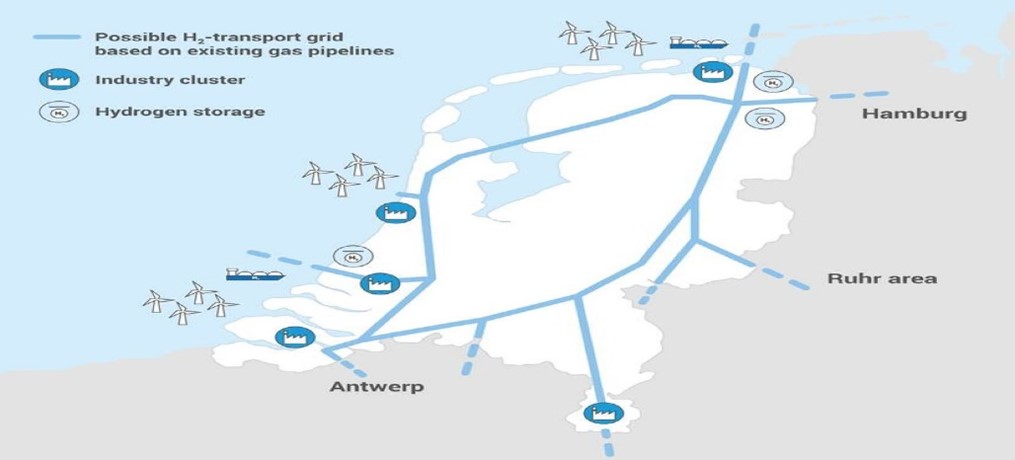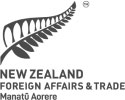Sustainability:
On this page
Summary
- The Netherlands is committed to achieving net zero carbon emissions by 2050. The transition to sustainable energy forms a key part of this plan.
- Alongside lifting sustainable electricity production, the Dutch government is prioritising the creation of a national ‘hydrogen backbone' – an infrastructure network linking the port of Rotterdam with other major industry clusters in the Netherlands, Germany, and Belgium.
- Security of energy supply chains and risks of sabotage and cybersecurity are front of mind for the Netherlands. The Netherlands is looking to ensure that any risks are well understood and appropriately managed.
- As geothermal energy is a relatively new technology in the Netherlands, New Zealand has an opportunity to contribute knowledge and expertise in the integration of geothermal energy into the Dutch energy sector.
- Hydrogen development also offers opportunities for collaboration. Should New Zealand look to export hydrogen, the Netherlands is an obvious partner, given its friendly business climate, and the expected demand.
Report
The Netherlands aims to achieve net zero carbon emissions by 2050 and numerous measures have been introduced to support this goal, including rejigging its energy mix.
Current energy mix
As of 2023, oil (41%) and gas (36%)(external link) are the Netherlands’ main energy sources both for direct use and for converting into fuels or electricity for final consumption. Groningen in the north of the Netherlands is home to Europe's largest gas field, making the Netherlands a net gas exporter for more than half a century, and generating a total of €416.8 billion for the government between 1965 and 2018. However, earthquakes in the villages around Groningen linked to the gas extraction, and anger at the slow process of compensating the communities impacted, led to the decision to close the field, despite the high quality of the existing infrastructure.
Without sufficient grid infrastructure or hydrogen storage for large amounts of new wind or solar power, and with limited nuclear power, the Netherlands today remains dependent on gas and liquefied natural gas (LNG) imports from Russia, Norway, the US, and Qatar. As the largest port for oil and LNG in Europe, Rotterdam is working with industrial partners to be in a similar position vis-à-vis hydrogen.
Reorganising and retaining significant investment
The Schoof government has retained the previous Rutte government’s €35 billion Climate Fund to drive the energy transition towards net zero. To assist with this, the Ministry of Economic Affairs and Climate is being divided into two separate ministries – ‘Economic Affairs’ and ‘Climate Policy and Green Growth'. Former Foreign Minister, Wopke Hoekstra, has also secured the role of European Commissioner of Climate, Net-Zero and Clean Growth.
A national ‘hydrogen backbone’
For the Netherlands to reach its goal to produce 35 TWh from wind and solar, it urgently needs solutions to store large amounts of energy to avoid further grid congestion. Green hydrogen offers one solution if parts of the Netherlands extensive 136,000 km gas network pipeline could be transformed for the transportation of hydrogen. This would accelerate the development of an open access and national ‘hydrogen backbone’. The existing natural gas distribution and storage system also provides opportunities for hydrogen distribution, solving the current problem of network congestion by bridging the seasonal and overnight fluctuations in the availability of renewable wind and solar energy. Importantly, any new or refurbished infrastructure would need to be built to be “colour-blind” to handle grey, blue, or green hydrogen.
The port of Rotterdam has the potential to become the main import hub for green hydrogen in Europe. The Dutch Enterprise Agency expects north-western Europe to become a net importer of clean hydrogen, as other countries with lower electricity costs, favourable wind conditions and plenty of sunshine invest in large-scale renewable hydrogen production. As the largest port for oil and LNG in Europe, Rotterdam is working with industrial partners to be in a similar position vis-à-vis hydrogen. Massive investment in infrastructure linking hydrogen storage and import locations in the Netherlands, Germany, Belgium and even Denmark, will be known as the 'hydrogen backbone’.

The plans and cash are there, but risk remains
There is strong interest in government tendering processes for major hydrogen-related projects. Meanwhile, industry continues to rely on the government to mitigate and/or shoulder much of the risk.
Renewables and e-mobility
The Netherlands is one of the most industrialised and densely populated nations in the world. Its large industrial sector requires huge amounts of high temperature process heat, posing challenges to finding alternatives for fossil-based feedstock. Major investment is planned in renewable energy, especially in offshore wind and solar energy. In the Dutch zone of the North Sea, planned projects for offshore wind parks will add up to 21GW of offshore wind capacity by 2030.
Dutch companies have a leading position in the supply and development of technology for wind turbines. One significant project is CrossWind, a joint venture between Eneco and Shell, which is developing an ‘intelligent’ offshore wind farm 28.5 kilometres off the west coast of the Netherlands. The ‘intelligent’ wind turbines can maintain the stability of the energy grid using real-time data, which allows the grid to respond to changing weather conditions. With an installed capacity of 759 MW, this subsidy-free offshore wind farm will generate at least 3.3 TWh per year, equivalent to 2.8% of the Netherlands' national electricity demand.
The uptake of electric vehicles in the Netherlands is the fastest growing in Europe. The Netherlands has set a target for 100% of new cars sold to be zero-emission by 2030. To accelerate this process, consumer support for the purchase of electric vehicles were put in place by the last government. While the measure will soon end, the end of subsidies is not expected to have a significant impact on demand, largely because the price of electric vehicles is dropping.
Geothermal energy
While geothermal energy is relatively new in the Netherlands, it is not uncommon to have buildings and even greenhouses heated by circulated water from shallow geothermal pipe systems. Wide scale planning for geothermal projects is currently under way. Geothermy Delft (GTD), a public-private project, has taken a major step towards a geothermal heat source(external link) for the Technical University of Delft campus, with a deep ‘heat-mining’ well drilling 2.5 kilometres below the city. The partners TU Delft, Aardyn(external link), Shell and Energy Management Netherlands (EBN) are making a follow-up investment, expecting the heat mine to heat the University and 10,000 houses in the city. Nevertheless, after the Groningen gas field debacle, there are concerns around the social licence to progress such projects at scale.
A word on nuclear
Nuclear energy will also play a bigger role in the Dutch energy picture after 2030. As part of the €35 billion climate fund, €14 billion has been earmarked for the construction of four new nuclear power plants, in addition to an existing nuclear power plant in the province of Zeeland. The first two are expected to be operational by 2035. Despite the heavy investment, the cost of the plants is expected to exceed €14 billion, and experts expect delays. Based on media reports from September 2024, there is a perception that private investors are reluctant to invest in nuclear power plants due to uncertainties, including questions about their economic viability.
Challenges
The Netherlands does not yet have the storage capacity and overall infrastructure to fully support the green transition and implementing the necessary 'backbone' infrastructure remains challenging due to the long-time horizons, scale of investment required, red tape and risk. With more wind turbines, solar farms, heat pumps and charging stations, but a serious lack of storage capacity, the Dutch grid is becoming increasingly congested. There are also concerns about the economic viability of sources such as nuclear power.
Security front of mind but the risks need to be appropriately bound
Supply chain security and risks of sabotage, espionage and cybersecurity are front of mind for the Dutch across all energy sources. Appropriately mitigating, managing, and evaluating the security risks are important but so is the need to ensure the risks are appropriately bound. In order to allow the energy transition to progress as affordably as possible, the government needs to be clear which components of certain technology present risks, and which do not.
Dutch media reported in September that all new wind farms built in the North Sea will have to meet strict safety and security requirements. As foreign investment in critical infrastructure becomes subject to more regulation, there will be strict reporting requirements on the supply and sourcing of components for wind farms, including on who is responsible for maintenance and who the 'owners' are, to prevent possible espionage and sabotage.
Opportunities for New Zealand
Geothermal energy has the potential to supply a significant proportion of the Netherlands’ energy needs. As it is a relatively new technology in the Netherlands, the equipment and processes are expensive, and the domestic knowledge base is limited. New Zealand has an opportunity to contribute knowledge and expertise in the integration of geothermal energy into the Dutch energy sector.
Hydrogen development also offers opportunities for collaboration. If New Zealand were to seek to export hydrogen, the Netherlands would be an obvious partner, given its friendly business climate, expected demand and the Port of Rotterdam's aim to have an operational hydrogen import hub by 2030.
The Netherlands regularly hosts major energy conferences and dialogues to bring government and industry together. It has signed Memoranda of Understanding and other hydrogen cooperation agreements with Australia, Canada, Indonesia, Japan, Morocco, Oman, the United Arab Emirates, and the United States. Information exchange between industry experts across the energy sector (geothermal, hydrogen, electrification) could also prove worthwhile.
More reports
View full list of market reports(external link)
If you would like to request a topic for reporting please email exports@mfat.net
Sign up for email alerts
To get email alerts when new reports are published, go to our subscription page(external link)
Learn more about exporting to this market
New Zealand Trade & Enterprise’s comprehensive market guides(external link) export regulations, business culture, market-entry strategies and more.
Disclaimer
This information released in this report aligns with the provisions of the Official Information Act 1982. The opinions and analysis expressed in this report are the author’s own and do not necessarily reflect the views or official policy position of the New Zealand Government. The Ministry of Foreign Affairs and Trade and the New Zealand Government take no responsibility for the accuracy of this report.
Copyright
Crown copyright ©. Website copyright statement is licensed under the Creative Commons Attribution 4.0 International licence(external link). In essence, you are free to copy, distribute and adapt the work, as long as you attribute the work to the Crown and abide by the other licence terms.

